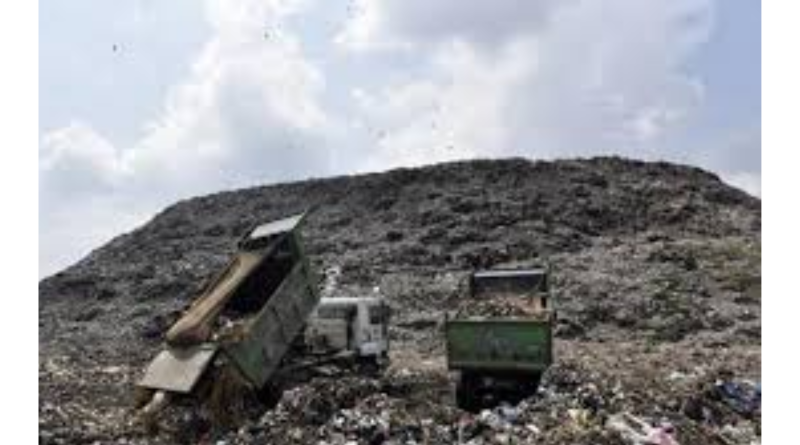As we continued to ignore basic logic, Delhi’s “solution” to its waste management problem from four decades ago has turned into a full-blown calamity. And it will be a catastrophe if we don’t wake up even now.
Early in the 1980s, Delhi faced a problem. Its streets and lanes were strewn with mountains of rotting, foul garbage. The city required a sizable area of land to dispose of its daily waste due to the demand of an expanding population. In 1984, the authorities eventually decided on a location in East Delhi.
A decade later, markets had expanded and consumerism had taken hold, altering our consumption habits and way of life. We felt more powerful and disregarded the conventional knowledge of waste segregation, recycling, reuse, and composting because we had more money in our pockets. Use and disposal governed our actions. We purchased more and more packaged goods, such as food and beverages. Single-use polybag usage exploded. Another location was picked at Bhalswa in Northwest Delhi to handle this fresh trash. When more homes, hotels, restaurants, and offices were built two years later, in 1996, a third dump site opened in South Delhi’s Okhla.
Dictionary definitions of the term “landfill” include the act of burying enormous amounts of trash or the location where trash is buried. It is a process by which something enters, not the other way around, by definition. You saturate both the earth and the air. But today, terms like “waste mountains,” “junk hills,” and “trash towers” are used in the media to describe what is visible in Ghazipur, Bhalswa, and Okhla. The 73-meter-tall Qutub Minar is almost as tall as the Ghazipur dump. The Bhalswa one is just a little bit shorter. The height of the Okhla mound is 42 metres. This is the case when a maximum height of 20 metres is allowed. Three crore metric tonnes of solid trash are built up in these three areas, which resemble ominous mountain ranges with vultures circling above, according to government statistics. It seems absurd.
The 20 million-person city of Delhi, which is already frequently named as the most polluted city in the world, has seen an increase in its environmental and health problems as a result of the garbage piles. The three places are situated on several acres of precious and rare public land worth at Rs 10,000 crore, according to cautious estimates quoted in court judgements.
Leachate, a thick, black liquid that seeps into the ground during rains, poisons the soil. Rain runoff mixes with the groundwater, which has already been dangerously depleted of its reserves, and travels via already polluted storm drains before meeting the Yamuna, which has been reduced to a filthy canal. Then, the mounds release methane and other toxic gases.
Furthermore, there are frequently occurring fires in these locations, some of which burn for weeks on end, which adds to the air issue by spewing up thick plumes of smoke.
The wealthy lament an intolerably strong stench when they are near these landfills, even with their car windows closed. Apartment buildings nearby as well as other business buildings like hotels and gas stations are also affected by the odour. The environments, however, are a nightmare for people who must live nearby, causing everything from cancer and odd births to asthma and skin allergies.
The three sites had to be shut down after they ran out of room for moving trash. Numerous estimates claim that in order to dispose of its solid waste, Delhi currently need 800 hectares of land and Rs 80,000 crore. Additionally, there is no land. No community wants a landfill nearby. It is useless to increase the size of the land. We’ll talk about it once more.
There are just too many possibilities if we want to address accountability for this problem while temporarily absolving the populace. However, the primary culpability rests with the local body that answers to the Centre.
In addition to the central pollution control board, central ministries of urban development and the environment have a role to play. The BJP has been in charge of the corporation for 15 years, and the party has held the prime ministerial position since 2014.
However, the DPCC, or pollution control committee, of the Delhi government, also has a supervisory duty. Because of the state of the three sites, the National Green Tribunal (NGT) has frequently levied heavy fines against it, with the biggest amount reaching Rs 900 crore. The company has received numerous fines from the DPCC in return.
No single party has held power over Delhi’s municipal corporation and Delhi at the same time for years, which has led to acrimonious politics. The AAP claims that landfills will be a key issue in its campaign for the forthcoming Delhi municipal election. Without a doubt, it is mostly the BJP’s failure. However, many would contend that the AAP’s motives are more political than genuine electoral support. Because the AAP’s record on environmental concerns isn’t particularly strong.
What then is the answer? When we comprehend the issues, we may better appreciate the solutions. A few facts, though, first. The majority of specialists concur that 50% of the solid waste can be composted or converted into biogas. It can be recycled in about 30% of the cases. Therefore, just 20% of the waste should ideally end up in landfills. Additionally, segregation guarantees clean recyclables and higher-quality compost created from organic waste.
But it’s obvious that’s not the case. According to official statistics, Delhi produces 11,000 metric tonnes of solid trash daily. Waste-to-energy, composting, or refuse-derived fuel plants only treat around half of it. The entire other half gets dumped in landfills without being treated. Consequently, the current state of affairs in a nation that frequently talks about.
In a perfect world, this is what ought to occur. For doorstep pickup, residents should separate their dry and moist waste. After recycling and composting, there should be very little garbage that needs to be deposited. We wouldn’t have three landfills of the current type if this had been the case. But due to a combination of resource shortage and ineffective government, the world is not ideal.
According to government reports based on home surveys, just 30% of the waste is separated at the source. Additionally, half of Delhi has lived in unlicensed neighbourhoods, many of which lack piped sewer networks and tap water. Expecting door-to-door trash pickup with sorting is a bit much.
As was done in Indore, the goal should be to gradually remove the landfills. Another illustration is the conversion of a 20-year-old garbage pile in Indraprastha into a public park with the addition of soil.
The corporation asserts that it is headed in that direction because at the three locations, which the NGT has nicknamed “time bombs,” 46 trommel machines have processed 77 lakh metric tonnes of legacy solid waste. This process needs to move along even faster.
So, are landfills really necessary? We do. For materials that aren’t combustible, non-biodegradable, or recyclable, as required by law, one is ideal, but only in that case. Even if waste-to-energy plants are necessary, they should only use materials that are allowed to burn.
The city will be able to significantly reduce the amount of money it currently spends on operating the hundreds of vehicles needed to transport waste to landfills and other such operations if we finish all of these duties. This will save money, which can be used for public-benefit initiatives like pollution control.
Therefore, we cannot do nothing and wait for the government to act. Shouldn’t we, as citizens, step up when the State falters? We may have chosen to separate the garbage. The garbage that was recyclable and reusable could have been recycled and used again. The compostable garbage may have been composted. We could have bought less packaged goods, and instead of polybags, we could have used cotton carrybags like in the past.
We can still. Since our survival is at stake, no effort is insignificant. Cities like Alleypey, Panjim, and Mysuru have succeeded with this. Delhi cannot, why? Why did you go that far? In Delhi under Lutyens, it occurs. It takes place near the Delhi Cantonment. The regions only make up a small portion of the metropolis, but we can repeat a successful pilot.
Let’s recall, as we draw to a close, that our response to the problem of the early 1980s has now exploded into a full-fledged crisis because we forsook common sense, the most fundamental rules of solid waste management, for over four decades. The city will soon be threatened with disaster if we don’t wake up immediately.
The post India’s Capital Delhi is drowning into its own garbage appeared first on OUR INDIA.



Average Rating